Robin Gill recipes: Our chef pulls a rabbit out of his hat for the Easter table
Flavoured in the pot rather than among the cabbages, rabbits are cheap and taste quite like chicken
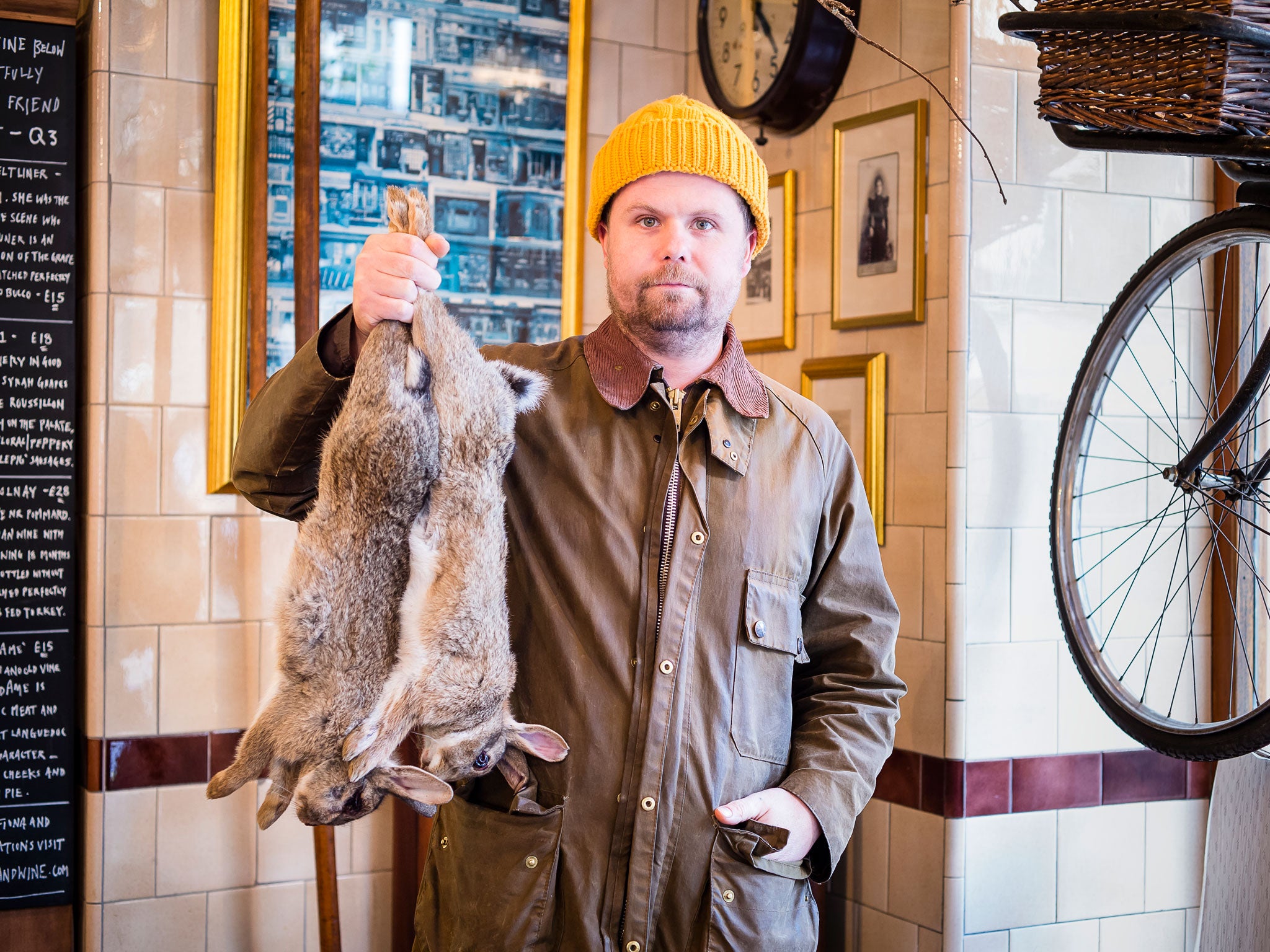
Your support helps us to tell the story
From reproductive rights to climate change to Big Tech, The Independent is on the ground when the story is developing. Whether it's investigating the financials of Elon Musk's pro-Trump PAC or producing our latest documentary, 'The A Word', which shines a light on the American women fighting for reproductive rights, we know how important it is to parse out the facts from the messaging.
At such a critical moment in US history, we need reporters on the ground. Your donation allows us to keep sending journalists to speak to both sides of the story.
The Independent is trusted by Americans across the entire political spectrum. And unlike many other quality news outlets, we choose not to lock Americans out of our reporting and analysis with paywalls. We believe quality journalism should be available to everyone, paid for by those who can afford it.
Your support makes all the difference.The rabbit as depicted in folklore is a symbol of good luck and mischief, a trickster using its cunning to outwit enemies. In Aztec mythology, 400 rabbit gods known as Centzon Totochtin represented fertility, parties and drunkenness. But more commonly we associate them with spring, Easter and the Easter Bunny.
Flavoured in the pot rather than among the cabbages, they're cheap and taste quite like chicken, and I couldn't think of a more appropriate thing to cook at Easter.
The dishes here were inspired by one of our late-night Bloodshot supper clubs. There was a crazy recipe created by my chefs Dean Parker and Ben Rand called "reservoir hogs"; all you need to know is that it was a gory, Tarantino-esque dish where whole hogs' heads were served with pig's blood syringes and surgical gloves as cutlery.
Anyway, in a strange way this was the inspiration for Simon Woodrow (head chef at Paradise Garage) and I to come up with a less intimidating but equally impressive beast feast.
It's not surprising that rabbit was Simon's choice of meat, as he had come across 400 of them a month during his time with Anthony Demetre at Arbutus, where it has been celebrated on the menu since day one.
This is not a 20-minute, midweek one-pan wonder; it requires time to prepare. The first thing you must do is speak to your favourite local butcher – mine is Turner and George in Islington – and order it in; it may take a week. Then you need to ask them to debone it for you. The piccalilli can be made a month or so in advance and is an absolute winner to have in the cupboard to liven up a ham sandwich.
These recipes are versatile and the rabbit could easily be replaced with chicken, guinea fowl or hare.
Robin Gill is chef-restaurateur of The Dairy, The Manor and Paradise Garage (@robingillchef)
Roast saddle of rabbit with radishes and gravy
Simon, our head chef at Paradise Garage, deserves all the credit this dish gets. It's nose-to-tail at its best and it gets loved ones around the table without costing a fortune.
Preparation: 2 hours
Cooking: 30 mins
Serves 4
For the rabbit saddle
1 saddle of rabbit, deboned (bones reserved for sauce), livers intact
Drizzle vegetable oil
12 slices pancetta
10g preserved lemon slices
4 sprigs tarragon
300g caul fat
Salt and pepper
For the rabbit gravy
30ml vegetable oil
8 three-joint chicken wings, chopped
Rabbit bones from the saddle, chopped
80g unsalted butter
4 cloves garlic, crushed
2 shallots, peeled and sliced
100ml white wine
50g plain flour, toasted at 200C for 15 minutes
800ml water
1 sprig lemon thyme
1 peel lemon zest
For the vegetables
200ml water
4g salt
50g butter
1 bunch breakfast radishes
2 baby gem lettuce
1 head red chicory
40g capers
½ bunch parsley, chopped
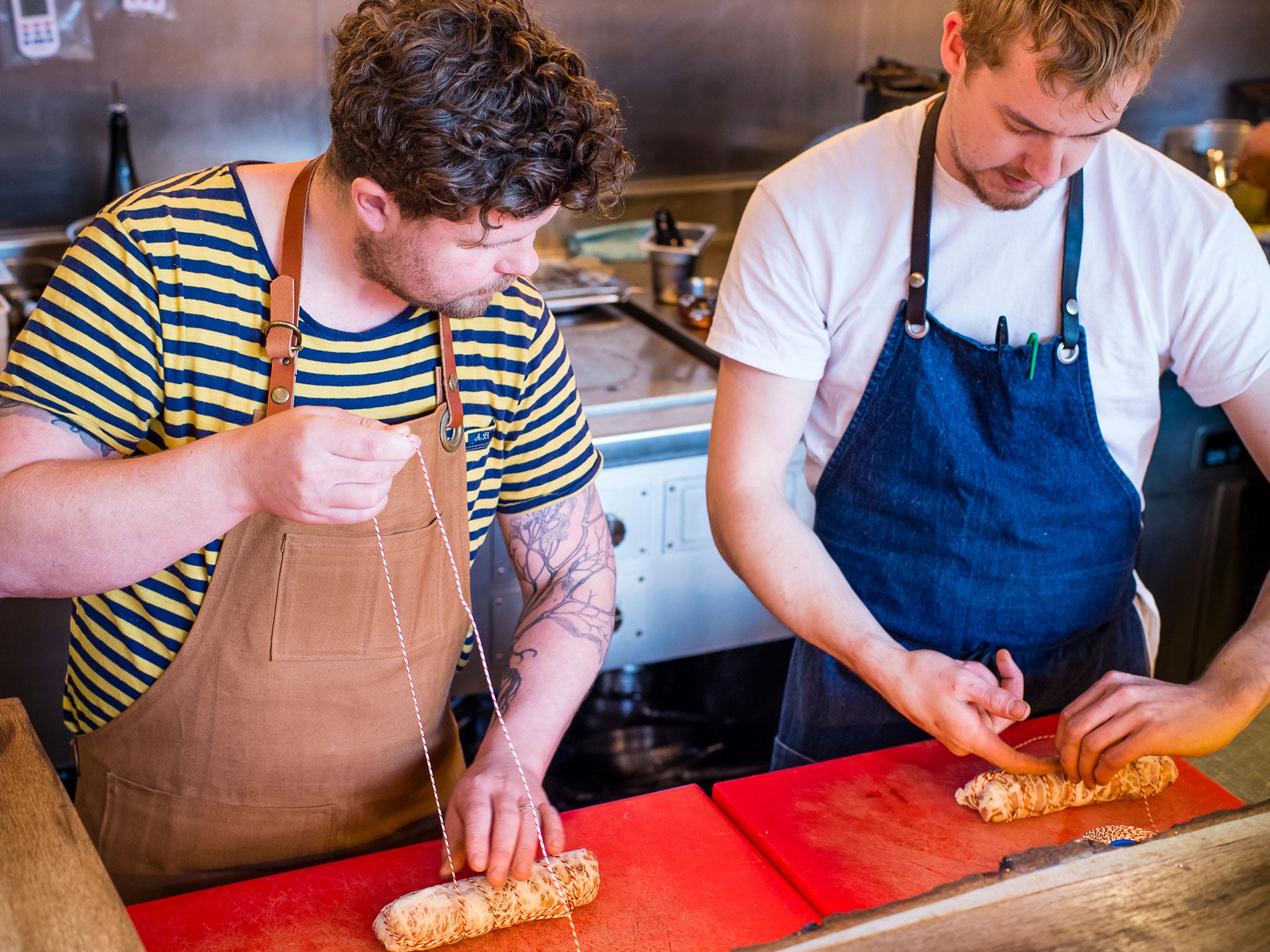
Start with the rabbit saddle. Place a pan over a high heat until smoking hot, drizzle a little vegetable oil over the livers to coat, add to the pan and seal all over, then remove and chill.
Lay 3 layers of cling film on a worktop and lay out the pancetta. Place the rabbit on top, skin-side down, and open the breasts out, exposing a gap in the centre between the fillets. Add the livers, preserved lemon, tarragon and season with salt and pepper.Roll the pancetta round the rabbit to create a sausage-like shape.
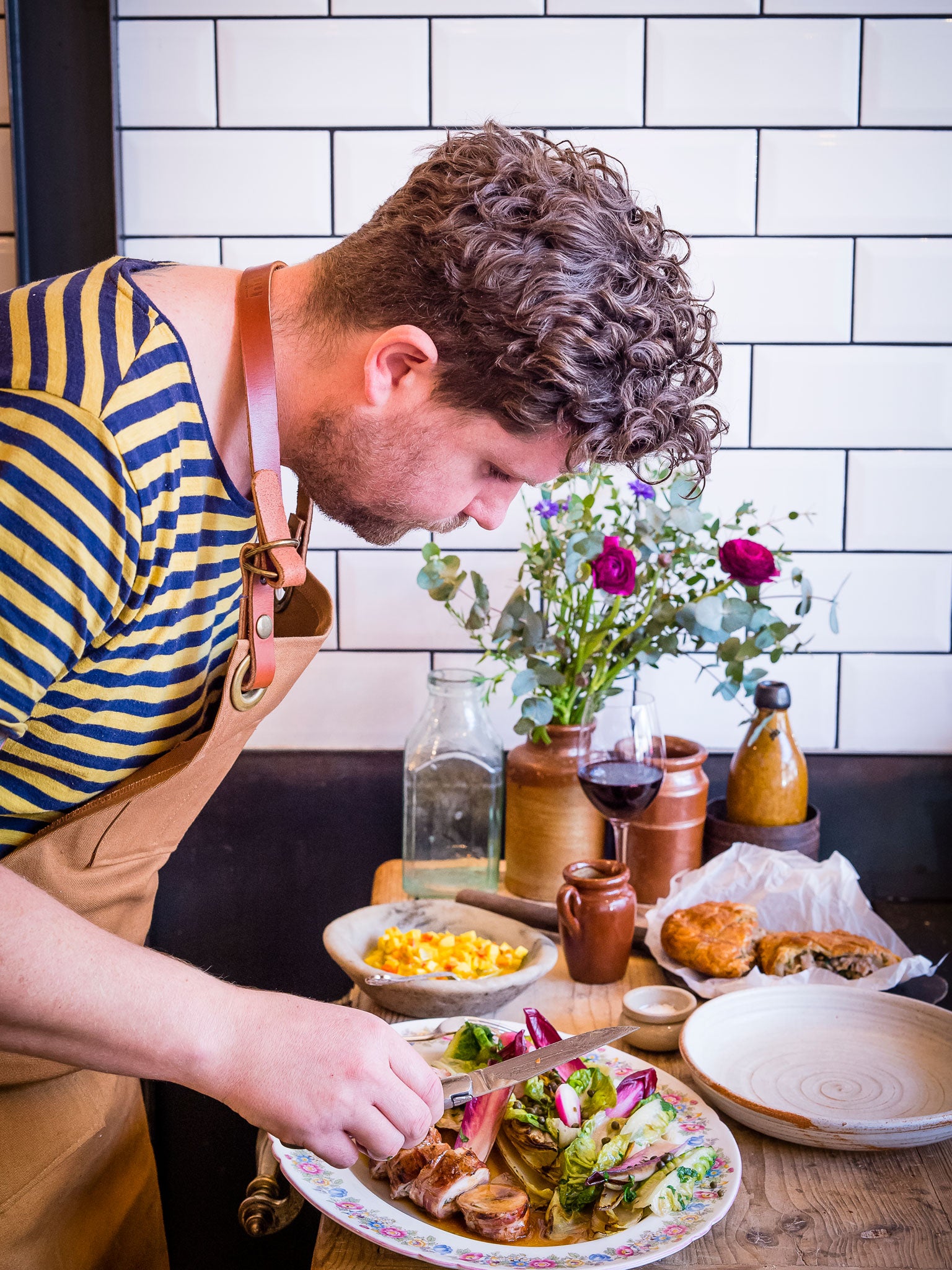
Lay down a layer of the caul fat just big enough to wrap around the rabbit, place the rabbit at the base and roll around the rabbit, folding in the sides, and securely tie with butcher's twine.
For the gravy, place a wide-bottomed pan over a high heat. Add the oil, chicken and rabbit bones and start to caramelise. Add the butter and caramelise until all the bones start to take on a golden-brown colour. Now add the garlic and shallots and cook until they are translucent. Remove the contents from the pan, drain the fat and reserve. Deglaze the pan with the wine, reduce by half and reserve.
Clean the base of the pan and add half of the reserved fat and the flour, and stir until it absorbs the fat. Next, add the bones-and-chicken mix and water and bring to the boil. Skim and simmer for 45 minutes, remove from the heat and add a sprig of thyme and lemon zest and the deglazed wine; infuse for 15 minutes. Strain and reduce to a gravy consistency.
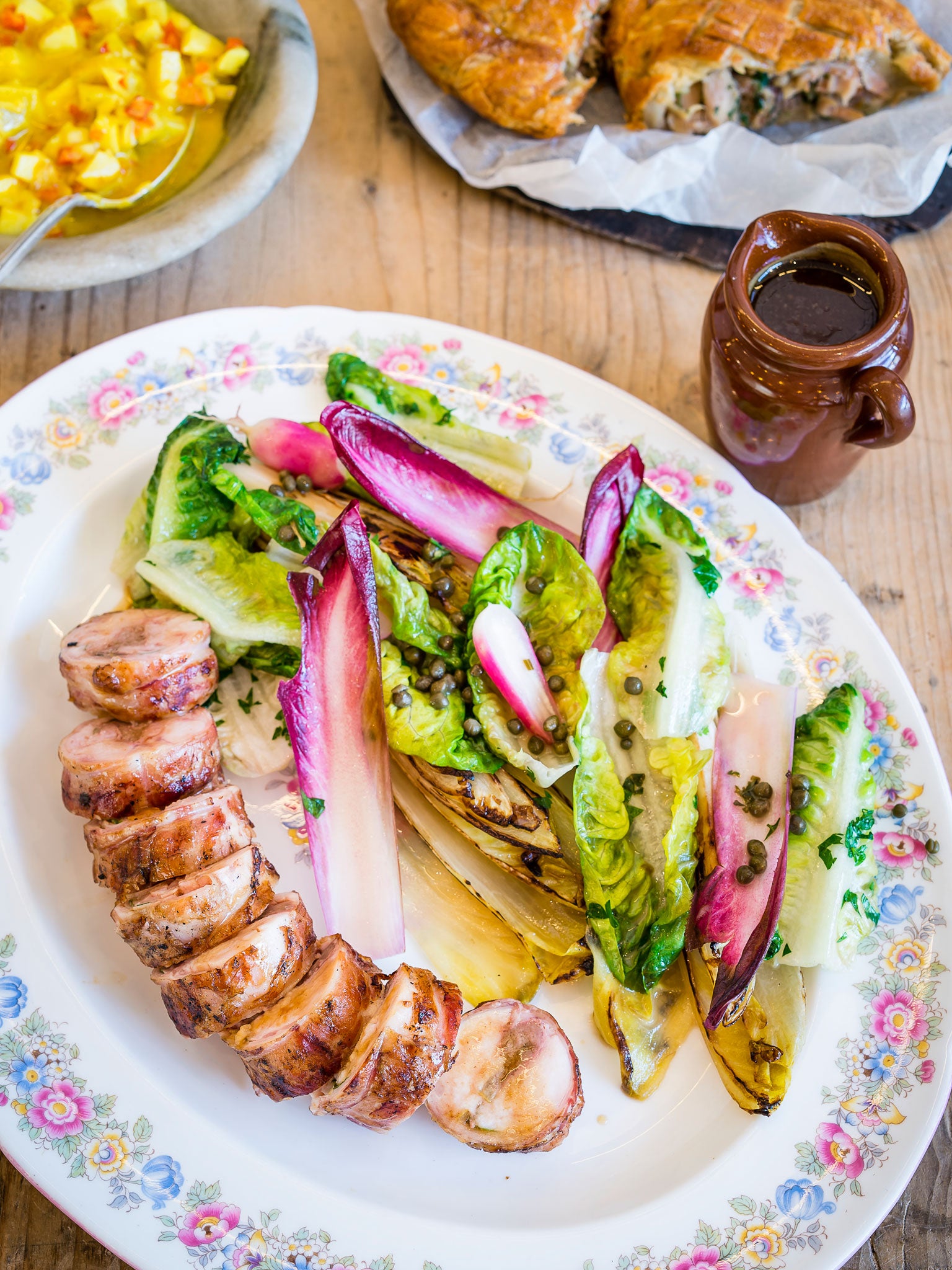
Preheat the oven to 210C. To cook the rabbit, place a suitable-sized pan on a medium/high heat. Add a little vegetable oil and seal the rabbit all over until it is golden-brown. Place in the oven for 5 minutes, then turn the rabbit and cook for another 5 minutes before allowing it to rest for 12 minutes
For the vegetables, make an emulsion with the water, salt and butter by bringing to the boil and whisking, then add the vegetables and cook until the lettuce starts to wilt. Drain. Now add the capers and parsley and toss. Add to the plate, carve the rabbit, place on top, heat through the gravy, and serve.
Rabbit turnover
There's nothing more comforting than a pie to warm the heart and tummy. Feel free to substitute chicken, duck or ham. You could make a heap of them and store them in the freezer. The piccalilli goes beautifully with this, but a pot of mustard and some pickles would also work quite nicely.
Preparation: 30 mins
Cooking: Just under 2 hours
Makes 3-4, serves 6-8
600ml duck fat
4 rabbit shoulders
Salt and black pepper
2 bay leaves
3 cloves garlic
1 medium carrot, peeled and diced
3 sticks celery, peeled and diced
1 white-skin onion, peeled and diced
100ml rabbit gravy (see recipe above)
1 tbsp Dijon mustard
1 sheet puff pastry
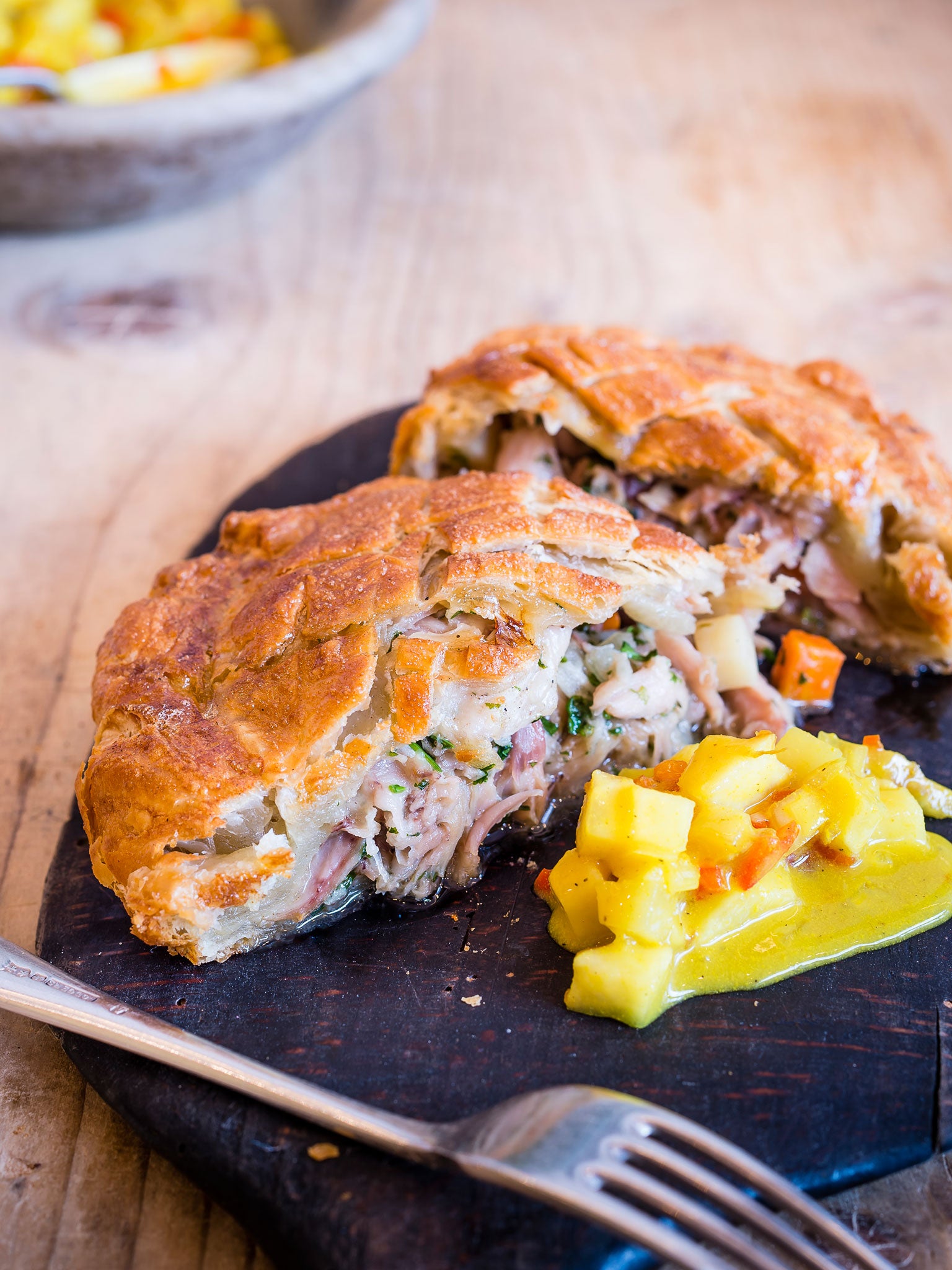
1 egg Place 500ml of the duck fat into a cassoulet pan. Season the shoulders generously with salt and pepper, add to the pan with the bay leaves and garlic, bring to a simmer and place in an oven at 140C for 1½ hours or until the meat falls away from the bone.
Place the diced vegetables into 3 separate pans with the remainder of the duck fat and cook the vegetables until they are tender, then chill.
While the rabbit is still warm, pick off the meat. Meanwhile, reduce the gravy from the rabbit saddle recipe by a third until it is quite thick. Add the meat, the vegetables and the mustard to the gravy, and adjust the seasoning. Chill the mix.
Cut the pastry into 4 triangles and place the mix into a corner of each. Roll the pastry over the mix until it is sealed in, crimp the sides of the pastry with a fork and brush the pie with egg wash.
Cook the pies at 180C for approximately 15 minutes and serve.
Artichoke piccalilli
This is an amazing variation on a traditional piccalilli. I love it with all types of cold meats – ham, game terrines and any type of pie. The flavours really develop after two weeks and I have deliberately given a large recipe batch to produce as it really is so versatile and makes for a lovely present.
Brining: 24 hours
Preparation: 1 hour
Makes 2kg
For the brine
4½ litres water
500g salt
For the piccalilli
1½kg Jerusalem artichokes
4 white-skin onion
600g red bell peppers
2 litres cider vinegar
75g plain white flower
100g mustard powder
400g caster sugar
60g fennel seeds, toasted and crushed
10g celery seeds, toasted and crushed
30g turmeric, toasted and crushed
1 pinch saffron, toasted and crushed
50g black peppercorns, toasted and crushed
20g cumin seeds, toasted and crushed
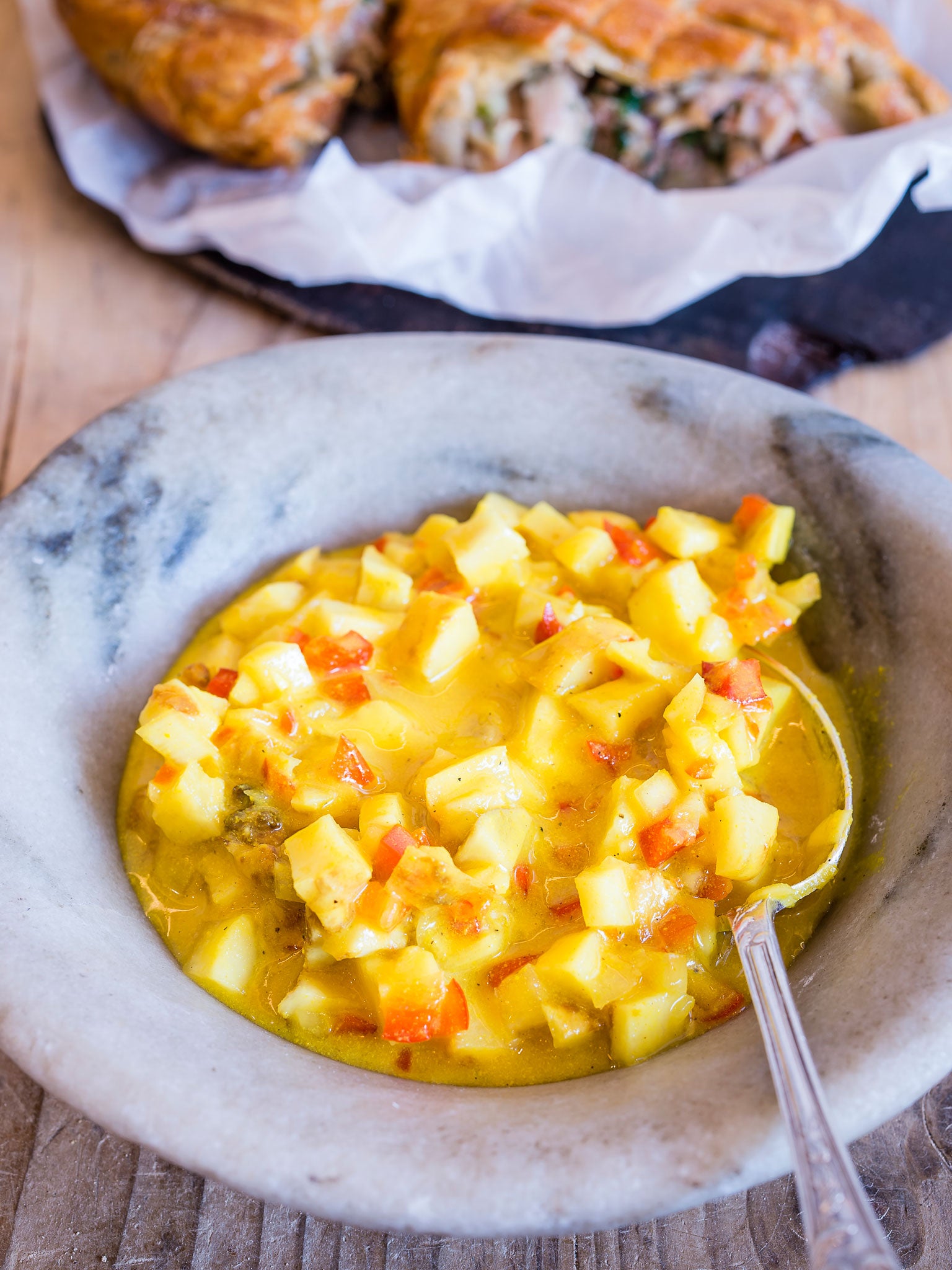
For the brine, place the salt and water in a pan and bring to a boil, simmer till the salt has dissolved, remove from the heat and chill. Once it has cooled, add the vegetables and chill for 24 hours.
Combine 200ml of the cider vinegar with the flour and mustard and whisk into a paste.
Add the remaining vinegar to the sugar and the crushed spices in a large pan and simmer over a medium/high heat. Gradually add the flour-mustard mix, stirring until the flour has cooked out and the liquor has thickened (about 12 minutes).
Drain the vegetables from the brine and place in sterilised kilner jars. Pour the hot pickle liquor over the veg, leaving a 2cm gap at the top. Seal the jars. The piccalilli will be good for six months.
Join our commenting forum
Join thought-provoking conversations, follow other Independent readers and see their replies
Comments